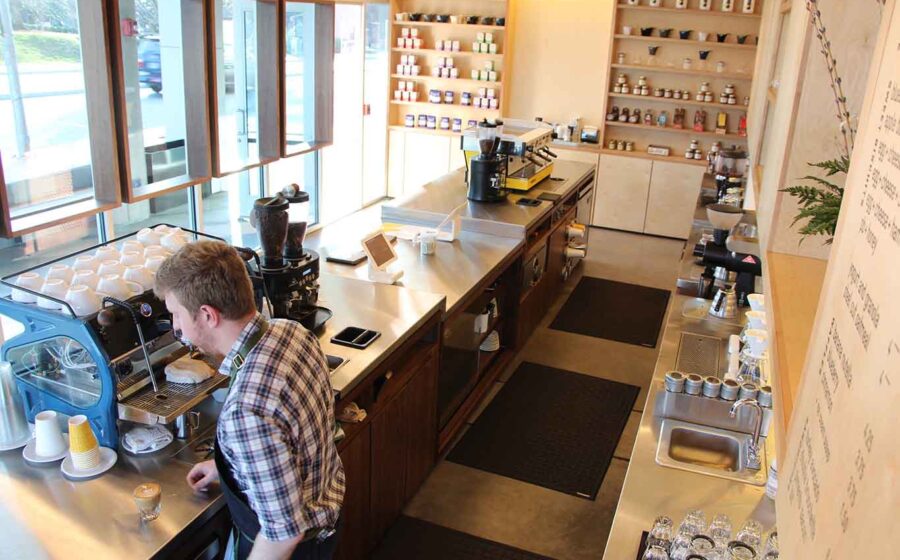[I]t took the coffee-drinking community in Raleigh, North Carolina, a little while to figure out what was so special about Jubala Coffee, one of the city’s first specialty coffee cafés. But when it did, there was a line out the door. That’s the dream for a coffeehouse owner. Andrew Cash quickly realized it could be a problem, too. “Customers would look at the line and leave,” he says.
When Cash began designing Jubala’s second café, fixing that problem was a priority. At his first shop, about 60 percent of customers stayed in and 40 percent were to-go. Why not serve them separately? To do it, he split the bar in two, with one side devoted to to-go customers and the other to sit-down customers. While customers on either side of the bar can order anything Jubala offers, the two sides have dedicated menus. Essentially, that means the takeaway menu is pared down to drinks that work well to go. So there’s no straight espresso on that menu, no pour-over, no egg option for their fresh-made biscuits.
“We will do anything to go, but the menu board starts at a cortado,” Cash says. “If you want a bacon biscuit to go, great. If you want an egg with it, that’s fine, but it will take four minutes.
The shop opened in February, and while the setup is taking customers a few attempts to master, Cash says it’s working the way he intended. The stay side of the bar is more spacious, with a seating area beside it that customers turn into after receiving their drink or placing their order. The La Marzocco Strada EE is even housed in clear panels, adding to the sense of openness he expects from baristas at that station. The barista on the take side, which abuts a wall, is expected to be friendly, of course, but with the understanding that, as Cash says, “the to-go side is about getting this drink out to you as quick as we can.”
Jubala’s café sits on the divide between North Carolina State University’s campus and downtown Raleigh. That seems like a circumstance with an even split between to-go and sit-down customers: students headed to class, workers on break, students studying, shoppers relaxing. It also seems like a good clientele with which to try a new bar design.
1) Espresso, Take Side: A three-group La Marzocco Strada PB, customized by Espresso Parts, holds down all to-go espresso drink orders. The “take” menu starts with a four-ounce cortado and maxes out at a twelve-ounce latte.
2) Grinding, Take Side: A Mahlkönig K30 Twin holds Counter Culture Coffee’s Hologram blend and a single-origin decaf.
3) Dropped Drip: A single-urn Fetco XTS is set between two cabinets, giving the café a gallon drip-brewer but removing it from sight.
4) Two Tap Towers: Cold-brew, iced tea, and beer from local brewery Trophy Beer come from six taps.
5) Marco and Mahlkönig: Splitting the back bar, a Mahlönig EK 43 is flanked by two Marco Über under-counter hot water towers. The grinder handles beans for the Fetco, pour-overs, and even stay-side decaf.
6) Filter, Stay Side: Beehive pour-overs set atop Acaia pearl scales handle up to four offerings.
7) In-counter Cleanup: Beside both espresso machines, a pitcher rinser and knockbox are set into the stainless steel bar.
8) Espresso, Stay Side: Another custom La Marzocco, this a two-group Strada EE, covers all “stay” orders, which include a wider range of drinks served in notNeutral ceramicware.
9) Grinding, Stay Side: Another K30 Twin holds rotating single-origin coffees, one that plays well with milk and one intended for straight espressos.
10) Biscuits: A Toastmaster warming drawer holds Jubala’s ace-in-the-hole: hot buttermilk biscuits.
11) Hideaway Cups: To-go cups are slotted into holders built into the counter, keeping them at hand and out of the way.
—Cory Eldridge’s is Fresh Cup‘s editor.
















